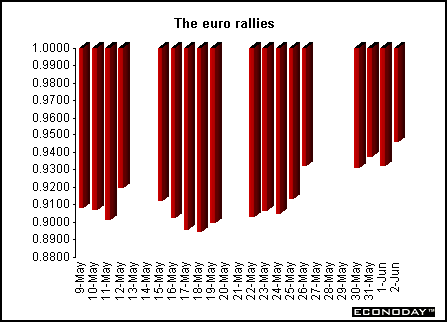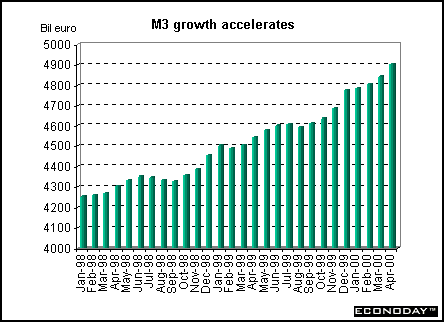| Previous Articles |
|
Markets
rise as growth estimates decline, or one month's numbers do not make
a trend
Europe and Britain - following
growth On Friday, the European markets burst with exuberance following the market friendly U.S. employment report. The data were considered to be benign and overseas market players now think that the Federal Reserve might not raise rates by the once-expected 50 basis points after all at their June 27th and 28th meeting. What the Fed does is critical to European and British markets. First, there is the interest rate spread. With the European Central Bank expected to raise interest rates 25 basis points at their Thursday meeting, the spread would narrow. The narrower spread would make EMU investments more attractive and cut flows into dollar denominated assets. Secondly, should the U.S. economy weaken, demand for both British and EMU exports, which have played an integral role in the European recovery, would also decline.
Renewed interest in TMT (technology, media and telecommunications) stocks continued the new economy/old economy split. The London FTSE 100 broke through the 6600 level for the first time since March 28th. However, it is still down 4.4 percent from the beginning of the year. On the week, the FTSE 100 jumped 409.5 points or 6.59 percent to close at 6626.40. The Paris CAC set a record close for 2000 on Friday. The index soared 544.37 points or 8.88 percent to end the week at 6626.40. The Frankfurt DAX climbed 496.20 points or 7.15 percent to 7434.53. Both the CAC and DAX are on the plus side for the year with the CAC up 12 percent and the DAX up 6.81 percent. As in London, TMT stocks were inspired by the Nasdaq and led the way up. Asia The Nikkei 225 rebounded from its six month low on May 26th. The markets soared even though investors are increasingly concerned about political instability in the run-up to Japan's June 25 election and the recent bad publicity suffered by the prime minister and his political party. First quarter 2000 gross domestic product will be released Friday. After two negative quarters, investors will be anxious to see if the economy has indeed recovered once again. The Nikkei recouped 791.92 points or 4.95 percent to end the week at 16,800.06.
Foreigners have been net sellers of Japanese equities for ten of the 11 weeks ending May 26, according to figures from the Tokyo stock exchange. Last week, foreigners sold 334.4 billion yen ($3.1 billion) more in shares than they bought. In Hong Kong, the Hang Seng vaulted 1561.40 points or 11.38 percent to end the week at 15,284.10. The Nasdaq's jump helped domestic investors recover their confidence in technology related shares. Property stocks also soared on the hopes that interest rates may be close to their peak.
Seven Nasdaq listed shares began trading on the Hong Kong Stock Exchange Wednesday for the first time and brings 24 hour world wide trading a step closer to reality. The experiment allows Asian market participants to trade in their own currencies at their usual trading times. Nasdaq Japan is scheduled to begin on June 19th. The goal is to create a truly global marketplace, which will tap new pools of capital and add liquidity to these companies. Currencies - A floor for the euro?
Looking ahead, the key event for the euro is the interest rate decision that the ECB will make on Thursday. The majority of analysts are expecting a 25 basis point increase, which would narrow the interest rate spread between the EMU and the United States to 2.5 percent. Currently, the main policy making interest rate for the ECB is 3.75 percent vs. 6.5 percent in the United States. Last week's economic data is pointing to slower U.S. growth making it less certain that the Federal Reserve will raise interest rates, dimming the allure of dollar deposits. Currency traders in the yen will watch Japanese household spending Tuesday and first quarter gross domestic product Friday for clues to Japan's economic strength. It would be helpful for the yen and the interest rate outlook if consumer spending begins to percolate. The yen rose after Bank of Japan Governor Masaru Hayami again hinted that the Bank of Japan might raise interest rates. However, given the precarious state of Japanese growth, it is unlikely to be soon.
The yen fell when a large insurance company failed raising concerns yet again about the financial sector's viability and condition of the Japanese economy. The yen rose on Friday only after the weak U.S. employment report. Indicator scoreboard
March trade surplus with the rest of the world shrank to E2.5 billion, down from a surplus of E6.6 billion a year earlier. March exports were up 18 percent when compared with last year while imports were up 26 percent. May Reuters purchasing managers' index slid to 59.7 from 60.7 in April. The prices index, which is not part of the overall PMI, showed a strong acceleration in inflation, rising to 76.7 in May from 73.7 in April. High oil prices and the weak exchange rate were the culprits. The EMU PMI is based on results from Germany, France, Italy, Spain, Ireland and Austria. PMI index readings above 50 signify expanding activity in the manufacturing sector.
Germany - First quarter pan-German seasonally adjusted gross domestic product rose 0.7 percent on the quarter and 2.3 percent when compared with last year. First quarter growth was boosted by a rise in plant and equipment investment while private consumption remained subdued. Private consumption slipped 0.6 percent in the first quarter but was up 0.4 percent when compared with last year. Equipment investment expanded 5.9 percent when compared with the fourth quarter of 1999 but grew 6.1 percent on the year.
France - April seasonally adjusted ILO unemployment rate fell below 10 percent to 9.8 percent. The ILO definition of unemployment excludes job seekers that did any work during the month. Compared to April 1999 when the ILO rate stood at 11.3 percent, unemployment was down 419,000 or 14.2 percent. The latest ILO rate is the lowest since 9.7 percent in September 1991.
April producer price index fell 0.4 percent after a 1.4 percent surge in March, for a 9.9 percent gain when compared with year. Excluding energy and food, however, the core PPI rose 0.5 percent on the month. Industry sales prices for semi-finished goods recorded sharp gains, with a monthly rise of 0.8 percent after 0.3 percent in March, for an increase of 4.6 percent on the year. Italy - April producer prices were unchanged on the month and rose 5.3 percent when compared with last year, as lower import prices of oil and other commodities were offset by a weak euro. March unadjusted industrial orders rose 18.9 percent on the year and following a 17.6 percent jump in February. Orders have shown double digit growth in four of the last five months. March domestic orders were up 22.1 percent on the year while foreign orders rose a solid 14.4 percent. March seasonally adjusted orders rose 7.5 percent on the month, after a 12.6 percent increase in February. Adjusted domestic orders rose 7.0 percent on the month after a rise of 12.7 percent in February, while overseas orders rose 8.3 percent on the month after 12.4 percent in February. Britain - May house prices fell a seasonally adjusted 0.4 percent on the month and the annual rise slowed to 15.8 percent from 17.5 percent the previous month, according to the Nationwide survey. Asia April seasonally adjusted unemployment rate eased to 4.8 percent from the post war record 4.9 percent recorded in March and February. The number of unemployed rose 1.2 percent from the previous year while the number of employed fell 0.4 percent. The labor force participation rate fell to 62.7 from 62.9 in April 1999.
South Korea - April merchandise trade surplus was $574.4 million, but the size of the surplus plunged 78 percent from a year earlier because of strong import growth. Customs cleared imports rose 49 percent when compared with a year earlier, while exports climbed 20 percent. April industrial output declined 2.3 percent on the month but rose 16.9 percent when compared with last year. The decline was due in part to the impact of a strike at local automakers and a public holiday for the April 13 parliamentary election. May consumer price index fell 0.1 percent but rose 1.1 percent when compared with last year. Lower petrochemical and industrial product prices offset increases in the services and housing sectors. The CPI rose 0.3 percent in the first five months of 2000 from the end of last year, marking the lowest growth for the period since 1965. Americas
BOTTOM LINE The sinking euro helped the recovery. But the euro should benefit from the positive outlook as well. This is a two-edged sword. It will subdue imported inflation that has made imports expensive but it will also make their exports, the lifeblood of the new expansion, more expensive. In Japan, the election campaign leading up to the June 25th balloting will be on center stage. Consumer spending and gross domestic product data will provide investors with new information about the economy's recovery and the success of the current government's economic policies.
For U.S. data releases, see this week's Simply Economics. |
||||||||||||||||||||||||||||||||||||||||||||||||||||||||||||||||||||||||||||||||||||||||||||||||||||||||||||||||||||||||||||||||||||||||||||||||||||||||||||||||||||||||||||||||||||||||||||||||||||||||||










